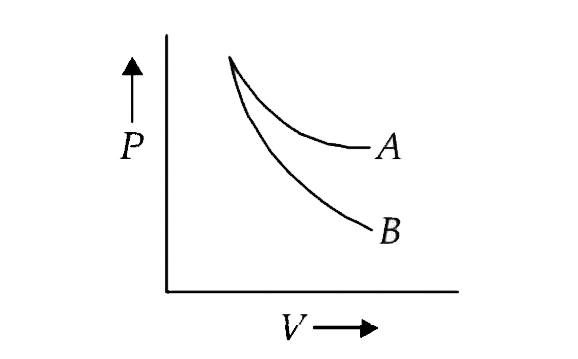Isothermal and adiabatic process are identical.
To determine whether the statement "Isothermal and adiabatic processes are identical" is true or false, we need to analyze both processes in detail.
1. Define Isothermal Process:
- An isothermal process is one in which the temperature of the system remains constant throughout the process. This means that any heat added to the system is used to do work, and there is no change in internal energy.
- Mathematically, for an ideal gas, the relationship can be expressed as PV=nRT, where R is the gas constant.
2. Characteristics of Isothermal Process:
- The process is generally slow, allowing the system to remain in thermal equilibrium.
- The change in internal energy (ΔU) for an ideal gas in an isothermal process is zero (ΔU=0).
- The work done (W) during an isothermal process can be calculated using the formula:
W=nRTln(VfVi)
- The pressure-volume (P-V) graph of an isothermal process is a hyperbola.
3. Define Adiabatic Process:
- An adiabatic process is one in which no heat is exchanged with the surroundings (Q=0). This means that any change in the internal energy of the system is equal to the work done on or by the system.
- For an ideal gas, the relationship can be expressed as PVγ=constant, where γ is the adiabatic index (ratio of specific heats).
4. Characteristics of Adiabatic Process:
- The process is generally fast, leading to significant changes in pressure and volume without heat transfer.
- The change in internal energy (ΔU) is equal to the work done (W), given by:
W=−ΔU
- The P-V graph of an adiabatic process is steeper than that of an isothermal process.
5. Comparison of Isothermal and Adiabatic Processes:
- Heat Transfer: In isothermal processes, heat is exchanged, while in adiabatic processes, there is no heat exchange.
- Temperature Change: Isothermal processes maintain constant temperature, whereas adiabatic processes can involve temperature changes.
- Work Done: The work done in both processes is calculated differently due to the differences in heat exchange and internal energy changes.
- Graphical Representation: The P-V graph of an isothermal process is a hyperbola, while that of an adiabatic process is steeper.
6. Conclusion:
- Since isothermal and adiabatic processes have fundamentally different characteristics and behaviors, the statement "Isothermal and adiabatic processes are identical" is false.
- An isothermal process is one in which the temperature of the system remains constant throughout the process. This means that any heat added to the system is used to do work, and there is no change in internal energy.
- Mathematically, for an ideal gas, the relationship can be expressed as PV=nRT, where R is the gas constant.
- The process is generally slow, allowing the system to remain in thermal equilibrium.
- The change in internal energy (ΔU) for an ideal gas in an isothermal process is zero (ΔU=0).
- The work done (W) during an isothermal process can be calculated using the formula:
W=nRTln(VfVi)
- The pressure-volume (P-V) graph of an isothermal process is a hyperbola.
- An adiabatic process is one in which no heat is exchanged with the surroundings (Q=0). This means that any change in the internal energy of the system is equal to the work done on or by the system.
- For an ideal gas, the relationship can be expressed as PVγ=constant, where γ is the adiabatic index (ratio of specific heats).
- The process is generally fast, leading to significant changes in pressure and volume without heat transfer.
- The change in internal energy (ΔU) is equal to the work done (W), given by:
W=−ΔU
- The P-V graph of an adiabatic process is steeper than that of an isothermal process.
- Heat Transfer: In isothermal processes, heat is exchanged, while in adiabatic processes, there is no heat exchange.
- Temperature Change: Isothermal processes maintain constant temperature, whereas adiabatic processes can involve temperature changes.
- Work Done: The work done in both processes is calculated differently due to the differences in heat exchange and internal energy changes.
- Graphical Representation: The P-V graph of an isothermal process is a hyperbola, while that of an adiabatic process is steeper.
- Since isothermal and adiabatic processes have fundamentally different characteristics and behaviors, the statement "Isothermal and adiabatic processes are identical" is false.
Topper's Solved these Questions
- HEAT AND TEMPERATUREBOOK - FIITJEECHAPTER - HEAT AND TEMPERATUREEXERCISE - ASSIGNMENT PROBLEMS (SUBJECTIVE) (LEVEL II AND III)
15 Videos
- HEAT AND TEMPERATUREBOOK - FIITJEECHAPTER - HEAT AND TEMPERATUREEXERCISE - ASSIGNMENT PROBLEMS (OBJECTIVE) (LEVEL-I)
50 Videos
- HEAT AND TEMPERATUREBOOK - FIITJEECHAPTER - HEAT AND TEMPERATUREEXERCISE - ASSIGNMENT PROBLEMS (SUBJECTIVE) (level-1) (FILL IN THE BLANKS)
5 Videos
- GRAVITATIONBOOK - FIITJEECHAPTER - GRAVITATIONEXERCISE - Numerical based Question
2 Videos
- KINEMATICSBOOK - FIITJEECHAPTER - KINEMATICSEXERCISE - NUMERICAL BASED QUESTIONS DECIMAL TYPE
5 Videos
Similar Questions
Knowledge Check
In an adiabatic process
Athe system exchanges heat with surroundingsBpressure is maintained constantCthere is perfect heat insulationDthe gas is isothermally expandedIn an adiabatic process
AΔT=0BΔQ=0CΔP=0DΔU=0For an adiabatic process
Aq=+WBΔE<WCΔE≥WDq=0
In an adiabatic process-
View SolutionIn a adiabatic process.
View SolutionFor adiabatic process
View SolutionFor an adiabatic process :
View SolutionAssertion: Isothermal and adiabatic, two processes are shown on p-V diagram. Process-1 is aidabatic and process-2 is isothermal.
Reason: At a given point, slope of adiabatic process =γ×slope of isothermal process.

View Solution

